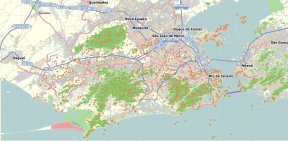This articleneeds additional citations forverification.(June 2015) |
TheCandelária Church(Portuguese:Igreja da Candelária,pronounced[iˈgɾeʒɐðɐkɐ̃deˈlaɾjɐ]) is an important historicalRoman Catholicchurch in the city ofRio de Janeiro,in southeasternBrazil.It was built and decorated during a long period, from 1775 to the late 19th century. The church combines aPortuguese colonialBaroquefaçadewith laterNeoclassicalandNeo-Renaissanceinterior elements.
| Candelária Church | |
|---|---|
Igreja da Candelária | |
 Façade of the Candelária Church—Igreja da Candelária(built 1775–1811) | |
| Religion | |
| Affiliation | Catholic |
| Rite | Roman Rite |
| Status | Active |
| Location | |
| Municipality | Rio de Janeiro |
| State | Rio de Janeiro |
| Country | Brazil |
| Geographic coordinates | 22°54′03″S43°10′40″W/ 22.900811°S 43.177894°W |
| Designated | 1938 |
| Reference no. | 51 |
History
editThe quasi-legendary history about the establishment of the church is that in the beginning of the 17th century a ship calledCandeláriaalmost sank during a storm on the sea. Upon arriving in Rio de Janeiro, a Portuguese couple, António Martins Palma and Leonor Gonçalves sponsored the building of a small chapel, fulfilling theoaththey made during the storm. This small chapel, dedicated toOur Lady of Candelária,was built around 1609.
In the second half of the 18th century, as the ancient chapel was in need of repair,Portuguesemilitary engineer Francisco João Roscio was put in charge of the project of a new, larger building. The works started in 1775 and the church – still unfinished – was inaugurated in 1811 in the presence ofKing John VI of Portugal,who at the time was in Rio with the whole Portuguese court. From this early period (1775–1811) the splendid main façade was built inBaroquestyle withneoclassicalelements. The interior of the church was, however, greatly modified afterwards, as thefloorplanwas changed from a one-aisledto a three-aislednave.[citation needed]
Enslaved people were baptised in the church, including Rosa Egipcíaca, the first black woman to write a book in Brazil. The book was a religious text revealing her visions, and was entitledSagrada Teologia do Amor Divino das Almas Peregrinas.[1]
Around 1856 the stone roofs of the aisles were completed, but thedomeover thecrossingwas still unfinished. The dome would only be completed in 1877 after the intervention of several architects and much discussion and planning. The dome and its eight statues were made in whiteLiozstone, inLisbon,and brought to Brazil by ship. When finished, the dome of the Candelária was the tallest structure in the city.
Interior
editAfter 1878 the interior of the Candelária church started being redesigned, in theNeo-Renaissancestyle. The walls and columns were covered with Italian marble of various colours, and abundant sculptural relief decoration. Brazilian painterJoão Zeferino da Costawas commissioned to paint the nave and inner part of the dome. On the ceiling of the main aisle, Zeferino da Costa and his assistants painted six panels telling the history of the church.
Other elements of interest include: the main altar by Brazilian architect Archimedes Memória; the various Germanstained-glasswindows; thebronzedoors (c. 1901) of the main entrance, by Portuguese sculptorAntónio Teixeira Lopes;and the two monumental bronzepulpitsin theArt-Nouveaustyle, by Portuguese sculptor Rodolfo Pinto do Couto (1931).
Architecture
editThe Candelária church is aLatin crosschurch with adomeover thetransept.The nave has threeaislesand a main chapel in theapse.The whole ensemble may have been inspired by the church at theConvent of Mafra,and in theEstrela BasílicaofLisbon,both in Portugal.
Façade
editThe main façade showsBaroqueinfluences in the design of the windows, doors, and towers, as well asneoclassicalinfluences in the bi-dimensionality of the façade and the triangularpediment.The façade contrasts the darkgraniteof windows, columns and other elements withwhitewashedwall segments, a typical characteristic of colonial churches in Rio.
Events
editThe church has been the site of several significant moments in the contemporary history of Brazil, such as the memorial mass of high school studentEdson Luís de Lima Souto,and theDiretas Jácampaign for popular direct presidential elections attended by over a million people in 1984.
The area around the church was the site of theCandelária massacreof July 23, 1993, which brought worldwide attention to the issue ofpolice brutalitytoward street children in Brazil.
The official cauldron for the2016 Summer Olympicswas placed in a plaza outside the church.[2]
Gallery
edit-
Candelária Church in 1856.
-
Facade
-
Altar
-
Ceiling of the altar and dome.
-
Dome
-
Ceiling of the Church.
-
Arch of the nave.
-
Sculpture beneath the pulpit.
-
Cross of Indulgence
-
Plaque
-
External view of the dome.
-
Ancient doors
See also
edit- Basilica of Our Lady of Candelaria(Medellín, Colombia)
- Basilica of Candelaria(Tenerife, Spain)
- Sé Catedral de Nossa Senhora da Candelária(Bissau, Guinea-Bissau)
References
edit- ^"Enslaved: Peoples of the Historical Slave Trade".enslaved.org.Retrieved2021-08-21.
- ^"Diminutive Rio 2016 cauldron complemented by massive kinetic sculpture".Dezeen.Retrieved11 August2016.
- Guia da Arquitetura Colonial, Neoclássica e Romântica no Rio de Janeiro.Editora Casa da Palavra. 2000. (in Portuguese)
- Introduction to the colonial architecture of Rio de Janeiro (in Portuguese)[1]
